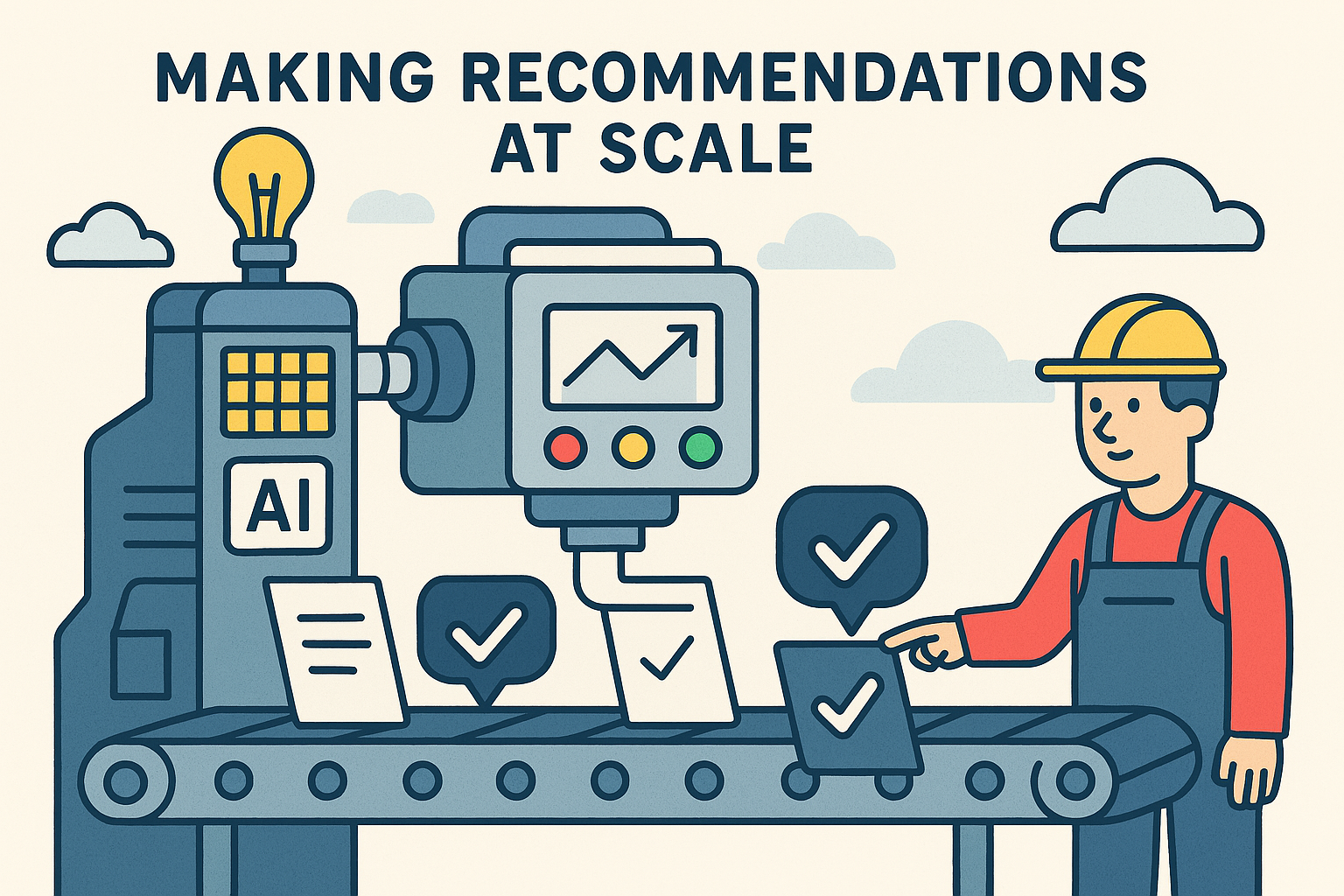Content Recommendation Systems
How can Computers Recommend Content?
yash101
Published 4/9/2025
Updated 4/3/2025
I kicked off this article as a set of notes while tinkering with components for a startup I’m trying to get off the ground. As I worked through the prototypes, I naturally gravitated towards the algorithms described here. They just evolved as the logical next step.
My original idea (still evident in the demos and examples) was to break down content into a few key numbers that capture its characteristics. I figured that if different pieces of content shared similar numbers, they’d likely be alike, and I could use that property to recommend content. It turns out that my initial concept is strikingly similar to how embeddings function in today’s state-of-the-art systems!
Since these algorithms emerged organically during my prototyping, there may exist a few inconsistencies in the nomenclature and variable names throughout the article.

Recommendation Systems - What & Why?
Ever been swamped with a massive library of content and wondered how to dish out the right stuff to the right folks? Think about a streaming service with heaps of movies and TV shows, or a social media app trying to keep users glued to their screens. That’s where recommendation systems come into play.
These systems aim to match users with the content they’re likely to love, but it isn’t a walk in the park. Every person’s different so we need to find a way through which we can get to know them.
So this leads to recommendation systems having two important jobs:
- Recommend content: serve up content that a user will resonate with
- Learn and adapt: Use feedback to fine-tune and improve future recommendations
And let’s be honest, a little boost to maximize shareholder value doesn’t hurt either.
So, how can we build a recommendation system? Let’s dive in!
Vectorization and Categorization

Imagine that you are the owner of a toy store. Your store sells all sorts of toys - dinosaurs, puppets, toy trucks, puzzles and so much more! How can you recommend the right toy to the right child?
A simple approach is to think about the different characteristics of each and every toy and note them down, say, in a spreadsheet. And we can group each and every toy based off these different characteristics.
Now, say we thought of 8 different characteristics and put them in a list. We can rate each and every toy in our toy store by these characteristics numerically. Putting together all 8 values for a single toy, we have vectorized the toy. For example:
- plush-toy
- animal
- mental
- red
- blue
- green
- gender-bias
- educational
We can then take each and every toy in the box of toys and rate each toy by the characteristics above.
plush-toy animal mental red blue green gender-bias educational
dinosaur 0.9 0.9 0.2 0.1 0.1 0.8 0.2 0.2
puppet 0.7 0.7 0.4 0.3 0.3 0.3 0.0 0.8
puzzle 0.0 0.1 0.9 0.3 0.3 0.3 0.0 0.8
truck 0.0 0.0 0.7 0.8 0.0 0.0 0.7 0.0
In the table above, each row represents a vector, and each vector describes an object.
Using Vectors for Content Recommendations

To find the best toy recommendations, we just need to compare vectors and look other vectors which look similar!
But, we aren’t trying to just compare toys. We are trying to make recommendations for a user, Bob. But no worries, we can still use a similar approach by creating a vector for Bob himself - a vector which would represent his ideal toy.
Hi, I’m Bob!
My favorite toy is Clifford, a big red dog plushie I have at home. I can’t sleep without it! Find me a new toy so he has a friend too!
We can create an initial vector for what we know ahout Bob and it would look like:
plush-toy animal mental red blue green gender-bias educational
bob 0.9 0.9 0.0 0.9 0.0 0.0 0.0 0.0
Since all we know about Bob is that he likes his “big red dog plushie”, we can create an initial embedding to match that.
Embeddings
Embeddings are a way to represent data (such as words, sentences, images, literally anything) as vectors in continuous space. Embeddings attempt to capture the meaning and context behind data, make it easy to compare two different data.
Since embeddings are vectors, they have the following characteristics:
- They represent a point in high-dimensional space
- Two similar vectors are “nearby”, and we can meaure the distance between them
- Vectors have a magnitude (
High quality embedding vectors have a few extra characteristics on top of being vectors:
- Two embeddings with a similar direction (they point in the same direction) have a similar meaning
- Two embeddings with very different directions have a very different meaning
- Magnitude can represent intensity or confidence. However, most embedding-based systems tend to ignore it by normalizing vectors
- Embedding vectors can be sparse or dense. This is data science speak of how data is represented in vectors. Most embeddings are somewhere between both 🙂
- Dense vectors are compact and almost all dimensions have non-zero values
- Sparse vectors are extremely large vectors in which most dimensions, except one or a few, are non-zero.
In the example we have used, the vectors we created above were, in fact, simple embeddings, with just 8 elements. These fixed-size vectors which captured enough information about each toy to allow us to compare two toys against each other numerically and find Bob his perfect toy. In typical machine learning applications, the vectors we use tend to be much bigger, easily somewhere between 128 and millions!
Nearest Neighbor (NN)
Similar embeddings convey a similar meaning, and we know that since embeddings are vectors, two similar embeddings will be located close to each other. Thus, we can use nearest neighbor algorithms to recommend content with a similar meaning. In the visualization below, 20 vectors have been plotted as points. The red point is our point of interest. The orange circle encloses the two nearest neighbors - the closest points to our point of interest.
How can we find the nearest neighbors?
Given our vector of interest,
Where
Cosine Similarity
Since two embedding vectors which point in a similar direction have similar meaning, how can we know if two vectors are pointing in the same direction? We can use cosine similarity which inherently normalizes both vectors under comparison and provides a score to test if both vectors point in the same direction.
- Cosine Similarity
- A measure of the whether two vectors point in the same directions, ranging from
The Mathematics
Our goal is to create a score that determines if two vectors are pointing in the same direction. How can we achieve that?
In linear algebra, we can take the dot product (also known as the inner product) of both vectors
Let’s investigate the three ways how we can calculate the dot product:
OR
OR
Where
Given all of this, how can we create a score which rates how similar of a direction both vectors point in? In the third formula to calculate the dot product, we have
In lamen terms, when both vectors point in the same direction,
We call the
And to calculate it, we can isolate it:
Or numerically (harder to read, easier to implement in code):
Learning from Feedback

To make a powerful content recommendation system, the system needs to be able to take feedback to update its own knowledge. How can we achieve that? We can make observations on the user’s behavior and update our knowledge base using those observations.
Let’s start by giving an initial recommendation:
Hi Bob, would you like this blue monkey plushie?
plush-toy animal mental red blue green gender-bias educational
blue-monkey 0.9 0.9 0.0 0.0 0.9 0.0 0.0 0.0
We can then get Bob’s feedback.
Bob: ew, that thing? It’s ugly! Am I 5? No thanks!
Now, using Bob’s feedback, we can update his embedding vector.
Where
We can also update the toy’s embedding vector:
Where
Let’s calculate, using
plush-toy animal mental red blue green gender-bias educational
bob (before) 0.9 0.9 0.0 0.9 0.0 0.0 0.0 0.0
blue-monkey (b) 0.9 0.9 0.0 0.0 0.9 0.0 0.0 0.0
bob (after) 0.81 0.81 0.0 0.9 -0.09 0.0 0.0 0.0
blue-monkey (a) 0.81 0.81 0.0 -0.09 0.9 0.0 0.0 0.0
Now, we have updated Bob’s embedding vector with his feedback, along with the toy’s embedding vector using his feedback!
Vector / Embedding Initialization

Now that we know how to use embeddings to recommend content, how do we actually compute our embeddings in the first place?
- When it comes to text data, we can use pretrained embeddings such as Word2vec, GloVe or FastText
- We can try frequency-based initialization (read my article on TF-IDF)
- SVD (singular value decomposition) or PCA (principal component analysis)
SVD digests information into simpler parts to uncover hidden relationships
PCA find the directions of greatest variance and tosses out the rest, leaving only the most important data - Transformers (such as BERT)
In fact, we can even use an LLM such as ChatGPT or Gemini to generate initial embeddings - that’s how I generated default embeddings for Æsop’s fables for the demo at the end!
Embedding Initialization Doesn’t need to be Perfect
Remember how our system can take feedback and learn? This means that if our vectors aren’t perfect, they will gradually improve over time! Thus, why even overengineer our vector initialization?
We can do something much simpler:
We can initialize our embedding vectors (for the data AND for the user) with a simple approach:
- Randomly initialize each component
- Use the average vector in your entire dataset as the starting vector
- Initialize each component as
Next, we can use apply feedback process gradually improve the accuracy of each embedding vector
This isn’t perfect since the system recommendations will be of low quality until it has had enough time and feedback to improve.
Demo - Recommender System for Æsop’s fables
Further Learning Tasks
- Read the code, understand how it works
- Update
ALPHAandBETA) variables and see how the learning changes. Try - Add and remove
feedbackfunction calls - Identify how to user vector changes, as well as how a story’s vector changes.
At Scale

To keep the above demo simple, we used a linear search where we performed a cosine similarity between each and every one of Æsop’s fables and the user’s vector. This does not scale since it requires
We can use vector databases, databases which are specifically tuned to be good at approximate nearest neighbor algorithm implementations. Vector databases such as Pinecone, and libraries such as FAISS efficiently store and retrieve vectors using approximate nearest neighbor methods. We will touch more into this later on.
Ethics and Bias
The goal of this article was to describe how a simple recommendation system based off embeddings works. The methods described in this article are fully unsupervised. They don’t rely on labeled data, but instead, try to cluster and find some meaning in it.
As machine learning predominantly controls more of our lives, we need to be mindful about ethics, and the harm it brings along with its benefits. It’s important to pay attention to how our models develop unintended biases, make unfair recommendations, or even learn from bad behavior (which the internet is full of).
Sources
- TF-IDF
- Wikipedia: Recommender system
- Datastax: What is Cosine Similarity
- Wikipedia: Cosine Similarity
- Wikipedia: Graph Database
- Wikipedia: Vector Database
- ChatGPT - for reviewing this article and assisting with visuals
- Notebook sources - on GitHub.